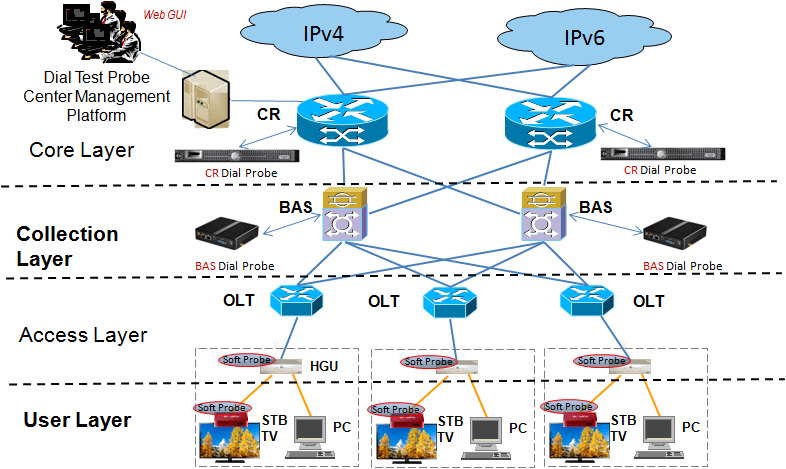With rapid development of global IP networks and applications, the home broadband access network has also entered the era of high-speed bandwidth upgrade in many countries. The construction of optical broadband end-to-end operation and maintenance systems has been promoted by major telecom operators as an important work schedule. However, many network operators still lack the Internet service quality assurance and proactive operation and maintenance tools for end users, resulting in inefficient operation and maintenance, difficulty in quickly responding to and solving customer’s problems, and affecting broadband users’ perception and satisfaction.
Dekscom EyeNet Internet Assurance System is a new generation of end-to-end IP network and service quality active test probe system. End-to-end IP networks can be implemented by deploying hardware probes at core, aggregation and access layers of the IP network, and deploying QoS agents in home gateways and IP set-top boxes in subscriber’s home networks. Performance and monitoring of Internet service quality, helping network operation and maintenance personnel to grasp the quality of experience of broadband users for various Internet applications (such as Web surfing, video streaming, instant messaging, gaming, etc.) to quickly diagnose various Internet services and network failures, and actively discover the performance problems of the user’s home network, IP bearer network, and TopN mainstream websites, thereby effectively improving the service quality of broadband users.

The main functions and applications of the EyeNet Internet Service Quality Assurance System include
• Quick network and service quality issues and failures isolation, various active test tasks can be launched from different nodes and user side of the network through remote operation at any time,which realize fast fault troubleshooting and delimitation of broadband users’ Internet access problems.
• Periodic active test tasks for occasional network and application problems troubleshooting, periodic active test tasks can be defined to collect long-term performance data of specific networks and applications to analyze the time rule of fault occurrence.
• Bulk active test from QoS agents based on network topology, user terminal groups can be defined according to network topology (i.e BAS, OLT, PON port) or geographic area (i.e prefecture, district, county, and cell), and batch active test tasks can be sent to a large number of set-top boxes or home gateway QoS agents. Troubleshoot and verify network problems for specific network elements and zones.
• Subscriber’s home network topology discovery and troubleshooting, the topology of the user’s home network can be discovered through the QoS agent deployed at the subscriber’shome gateway, including various terminal devicessuch as WiFi router and Internet terminals (i.e computers, pads, mobile phones, and set-top boxes). The problem of home network for the user and the carrier network problem for the operator can be isolated.
• Internet traffic and user behavior analysis, passive monitoring and packet capture analysis of data flow through home gateway are carried out to analyze the composition of user’s Internet traffic, alarm and intercept abnormal traffic (i.e. traffic passing through, network attacks, etc.) and potential security hazards (i.e. visiting phishing websites).
• End-user centered Internet service optimization, on the premise of not violating users’ privacy, collecting certain users’ Internet data (such as the frequently used and accessed URL) is convenient for the targeted users to optimize the Internet experience quality and to fine the Internet business operation.




